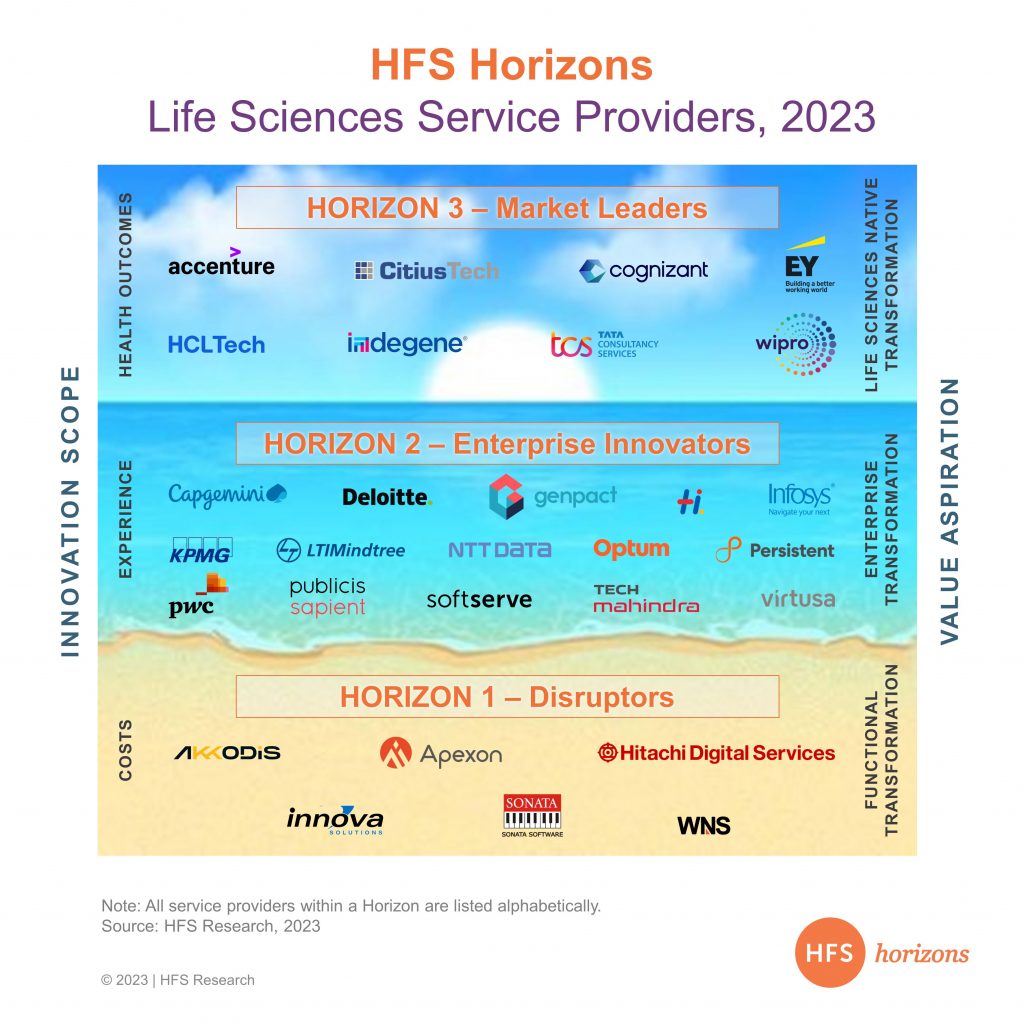COVID-19 shone a bright light on life sciences with unprecedented results—enterprises getting the new COVID-19 vaccine to market in less than a year. Life sciences enterprises’ ability to create new life-saving therapies, sophisticated medical devices, and other health vehicles continues to be astounding. That progress, however, has been possible because of an ecosystem approach that includes technology and service providers, academia, startups, and various other stakeholders.
The ecosystem approach will be particularly critical to managing pricing headwinds due to Medicare in the US, democratizing research with GenAI, and expanding hyperpersonalization.
In the HFS Horizons: Life Sciences Service Providers, 2023 study, we evaluated 29 service providers for their ability to address the cost (Horizon 1), experience (Horizon 2), and health outcomes (Horizon 3) for health consumers globally.
Exhibit 1: Eight providers can address all attributes of the triple aim of care: reducing costs, enhancing the experience of care, and improving health outcomes 
Note: Service providers within each Horizon are listed alphabetically.
Service providers bring a renewed level of sophistication unseen pre-pandemic
While life sciences get credit for the incredible successes of life-saving therapies or life-improving devices, the reality is those achievements are possible only because of partnerships with service providers and other stakeholders. Service providers have made significant investments in attracting expert domain, functional, and technical talent, adopting emerging technologies to develop critical accelerators and solutions, developing strategic ecosystem partnerships, and creating infrastructure capacity to be a service provider and force multiplier for the life sciences industry.
The combination has given most service providers the ability to address the entire value chain, including clinical research with wet and dry labs, clinical trials, smart manufacturing, intelligent supply chains, and a deep understanding of regulations at a global scale. One could argue that several providers can independently take molecules to market.
The key to differentiation and sustainable success is the ecosystem
The study unearthed the different levels of ecosystem maturity service providers have cobbled together and the rationale driving those partnerships. At one end of the spectrum, we have providers with the rationale that leveraging scale and brand recognition drives an ecosystem of enterprise platforms and hyperscalers. On the other end of the spectrum, the rationale to create differentiated offerings, accelerate outcomes, and be at the leading edge of changes drives ecosystems that include academia, startups, and life sciences–specific players buttressed by enterprise platforms. The efficacy of the different types of ecosystems will likely be reflected in the sophistication of offerings, quality of outcomes, and growth.
Despite progress in capabilities, there continues to be a bias toward selling services versus delivering outcomes
Value-based constructs (VBC) on the front end (payer to pharma) are growing in Europe but not in the US. However, given that the US Centers for Medicare and Medicaid (CMS) has now been authorized to negotiate prices on select drugs starting in 2026, it’s likely VBC may not remain so foreign in the US. Despite that direction, there is still a very strong bias for life sciences and service providers to largely engage in capabilities based on contracts rather than outcomes. This legacy orientation will continue to drive costs up without any true accountability. We need life sciences enterprises and service providers to step up and address outcomes in contracts to make a difference to the true cost borne by all those who pay.
The Bottom Line: Life sciences enterprises’ desire to cure diseases faster is only matched by the en masse increase in the sophistication of service providers’ capabilities.
Climate change, political and societal polarization at home, and armed conflicts continue to make the world a dangerous place. The frequency of pandemics, increase in rare diseases, and prevalence of chronic conditions make the situation dire. In this context, a life sciences orientation combined with service providers’ capabilities give us more than hope that we will have some of the tools to keep us healthy.
HFS subscribers can download the report here.
Posted in : Digital OneOffice, Healthcare, Healthcare and Outsourcing, HFS Horizons, Life Sciences, Uncategorized






